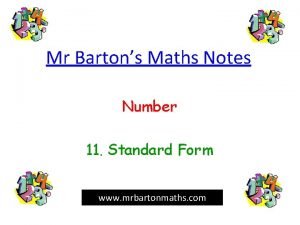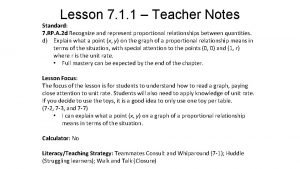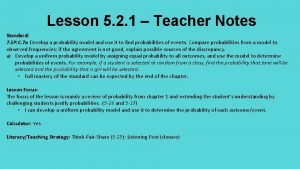Lesson 9 2 1 Teacher Notes Standard 7







- Slides: 7

Lesson 9. 2. 1 – Teacher Notes Standard: 7. G. B. 6 Solve real world and mathematical problems involving area, volume and surface area of two- and three-dimensional objects composed of triangles, quadrilaterals, polygons, cubes, and right prisms. • Full mastery can be expected by the end of the chapter. Lesson Focus: The focus of the lesson is to introduce volume and surface area. (9 -53) • I can recall and deconstruct the formula for volume three-dimensional objects composed of cubes, and right prisms. Calculator: Yes Literacy/Teaching Strategy: Think-Ink-Pair-Share (9 -51); Hot Potato (9 -53)

Bell Work

In your work with two‑dimensional (flat) shapes, you have described their dimensions, their perimeters, and their areas. For three‑dimensional shapes — shapes that have length, width, and depth — you can measure the lengths of their edges and calculate the areas of their faces (sides). Three‑dimensional shapes can also be described by their volumes, or how much space they enclose. Today you will work with rectangle-based prisms. As you work, keep these questions in mind: • How many cubes would it take to fill it? • How many squares would it take to cover the outside of it?

9 -51. PERFECT PACKAGING Cereal boxes come in different shapes and sizes. Some are tall and skinny, while others are shorter or deeper. The Bravo Breakfast cereal company is considering changing the size of its box. The staff members need some data to help them make the best choice. The company currently packages its Morning Math Crunch cereal in a box that is 2" deep by 4" wide by 8" tall, as pictured at right. This shape is called a right rectangular prism because the top and bottom faces are rectangles that are congruent (same size and shape) and parallel to each other. These are called the bases. The other faces (sides of the box) are also rectangles that are perpendicular (at a right angle) to the bases. Use a set of cubes to build a model of this box. Assume that the edge of one cube represents 1"of length on the real cereal box. a. Describe the box as completely as you can. Include the information below. • What shapes do you see when you look at the faces of the box? • What lengths or other measurements can you describe? • Sketch each shape on your paper, and label it completely.

b. The cardboard sides of the box are called its faces. How much cardboard is needed to create all six of the faces of the box? Work with your team to develop a method for calculating this amount. Discuss the kind of units to use. Be ready to explain your method to the class. c. The number of square units that it takes to cover the outside of an object, like the amount of cardboard you found in part (b), is called the object’s surface area. The volume of a shape is the measure of how much it will hold. Volume is measured in cubic units. How many cubes did you use to make this model of the cereal box? How many cubic inches of cereal will the box hold?

9 -53. Use cubes to build each prism below. Find the surface area and volume of each shape. a. b. c. Use at least 15 cubes to build a prism of your own design. Sketch the prism and find its surface area and volume.

Practice Use a number line to solve the following problems: 1. (-15) + 7 = 5. 2 + (-17) = 2. 10 + (-12) = 6. (-10) + (-4) = 3. 0 – (-6) = 7. 9 – (-1) = 4. (-3) – 4 = 8. (-7) + (-2) =













